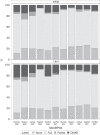Change in Code Status Orders of Hospitalized Adults With COVID-19 Throughout the Pandemic: A Retrospective Cohort Study
- PMID: 37022771
- PMCID: PMC10623069
- DOI: 10.1089/jpm.2022.0578
Change in Code Status Orders of Hospitalized Adults With COVID-19 Throughout the Pandemic: A Retrospective Cohort Study
Abstract
Aim: Our aim was to examine how code status orders for patients hospitalized with COVID-19 changed over time as the pandemic progressed and outcomes improved. Methods: This retrospective cohort study was performed at a single academic center in the United States. Adults admitted between March 1, 2020, and December 31, 2021, who tested positive for COVID-19, were included. The study period included four institutional hospitalization surges. Demographic and outcome data were collected and code status orders during admission were trended. Data were analyzed with multivariable analysis to identify predictors of code status. Results: A total of 3615 patients were included with full code (62.7%) being the most common final code status order followed by do-not-attempt-resuscitation (DNAR) (18.1%). Time of admission (per every six months) was an independent predictor of final full compared to DNAR/partial code status (p = 0.04). Limited resuscitation preference (DNAR or partial) decreased from over 20% in the first two surges to 10.8% and 15.6% of patients in the last two surges. Other independent predictors of final code status included body mass index (p < 0.05), Black versus White race (0.64, p = 0.01), time spent in the intensive care unit (4.28, p = <0.001), age (2.11, p = <0.001), and Charlson comorbidity index (1.05, p = <0.001). Conclusions: Over time, adults admitted to the hospital with COVID-19 were less likely to have a DNAR or partial code status order with persistent decrease occurring after March 2021. A trend toward decreased code status documentation as the pandemic progressed was observed.
Keywords: COVID-19; advanced care planning; cardiopulmonary arrest; do-not-attempt-resuscitation; resuscitation preferences.
Conflict of interest statement
No competing financial interests exist.
Figures


Similar articles
-
If Your Heart Were to Stop: Characterization and Comparison of Code Status Orders in Adult Patients Admitted with COVID-19.J Palliat Med. 2022 Jun;25(6):888-896. doi: 10.1089/jpm.2021.0486. Epub 2021 Dec 30. J Palliat Med. 2022. PMID: 34967678 Free PMC article.
-
Identifying Prevalence and Potential Predictors of Do-Not-Attempt-Resuscitation Orders to Facilitate Preoperative Discussions on Code Status.Am J Hosp Palliat Care. 2025 Apr;42(4):396-403. doi: 10.1177/10499091241268589. Epub 2024 Jul 30. Am J Hosp Palliat Care. 2025. PMID: 39075980
-
Impact of the COVID-19 Public Health Crisis and a Structured COVID Unit on Physician Behaviors in Code Status Ordering.Am J Hosp Palliat Care. 2024 Sep;41(9):1076-1084. doi: 10.1177/10499091231204943. Epub 2023 Oct 2. Am J Hosp Palliat Care. 2024. PMID: 37786255 Free PMC article.
-
Racial disparities in the frequency and timing of code status orders among women with breast cancer.BMC Cancer. 2024 Nov 19;24(1):1426. doi: 10.1186/s12885-024-13132-6. BMC Cancer. 2024. PMID: 39563219 Free PMC article.
-
Admission Code Status and End-of-life Care for Hospitalized Patients With COVID-19.J Pain Symptom Manage. 2022 Oct;64(4):359-369. doi: 10.1016/j.jpainsymman.2022.06.014. Epub 2022 Jun 25. J Pain Symptom Manage. 2022. PMID: 35764202 Free PMC article.
Cited by
-
Do-Not-Resuscitate Orders by COVID-19 Status Throughout the First Year of the COVID-19 Pandemic.Chest. 2024 Mar;165(3):601-609. doi: 10.1016/j.chest.2023.09.024. Epub 2023 Sep 29. Chest. 2024. PMID: 37778695 Free PMC article.
References
Publication types
MeSH terms
Grants and funding
LinkOut - more resources
Full Text Sources
Medical

